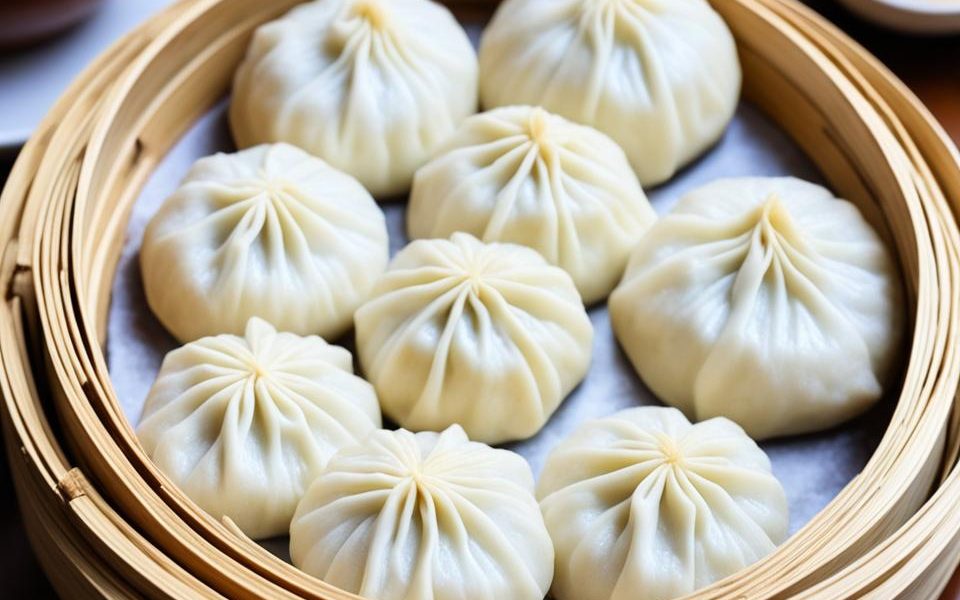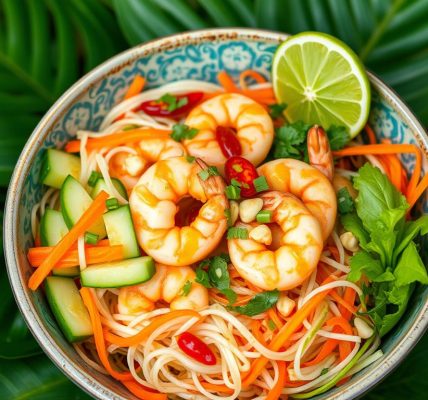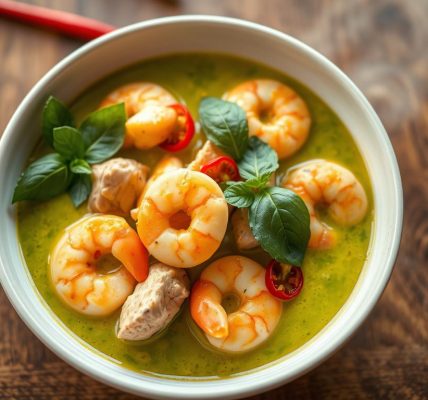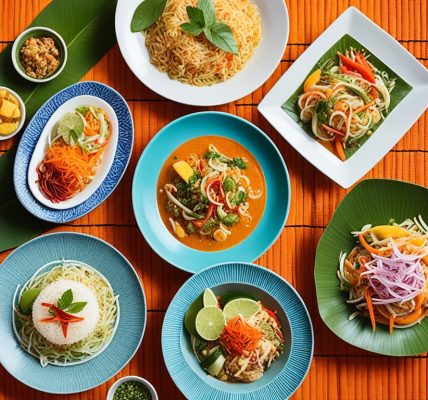Baozi, the beloved Chinese steamed buns, have won the hearts of food lovers around the world. These soft, fluffy treats are more than just a food item in Chinese cuisine. They are a symbol of Chinese culinary creativity and skill. We will explore baozi’s definition, origins, types, and how they are made in this guide.
Baozi are a favorite in dim sum and a common street food in China. Their aroma fills the air in places like Beijing’s night markets and Hong Kong’s alleys. It invites people to try this tasty treat. This article will take you on a journey through baozi’s history and flavors, whether you’re new to Chinese food or already love it.
Read more interesting information at ::ds-collection
What are Baozi?
Baozi, also known as “bao” or “buns,” are a favorite in Chinese food. They are fluffy, steamed buns filled with tasty or sweet stuff. They make a great snack or meal.
Definition and Origins
Baozi have a long history in ancient China. The name “baozi” means “wrapping buns.” The dough is soft and yeast-leavened. It’s filled with different ingredients and steamed to make a soft, bite-sized treat.
Varieties and Fillings
There are many kinds of baozi, each with its own special filling. Some popular ones are:
- Pork Buns – With a savory minced pork inside
- Vegetable Buns – Stuffed with veggies like cabbage, mushrooms, or bean sprouts
- Xiaolongbao – These are the soup-filled dumplings everyone loves
Baozi offer many flavors, pleasing all tastes and diets. You can choose from classic pork or tasty vegetable fillings. Exploring baozi is a real treat.
“Baozi are not only delicious but also a testament to the rich culinary heritage of China.”
The Baozi Dough
The secret to making delicious baozi, those soft Chinese steamed buns, is in the dough. This dough is the base for many Asian snacks, both savory and sweet. Let’s look at the main ingredients and how to make this dough into a tasty treat.
Ingredients and Preparation
The basic baozi dough has flour, yeast, water, and sometimes sugar or oil. The mix can change based on the region or what you like, but the basic steps are the same.
- Use high-quality flour, like all-purpose or bread flour, for a soft texture.
- Activate the yeast in warm water to make it work and add air to the dough.
- Knead the dough well to make it soft and chewy.
- Let the dough rise until it’s twice its size.
- Punch down the dough to get rid of air, then cut it into pieces for filling and shaping.
Putting care into the baozi dough makes these buns special. Whether you’re making a savory or sweet version, getting the dough right is key to the baozi magic.
| Ingredient | Amount |
|---|---|
| All-purpose flour | 2 cups |
| Active dry yeast | 1 teaspoon |
| Warm water | 3/4 cup |
| Granulated sugar | 1 tablespoon |
| Vegetable oil | 1 tablespoon |
With the right yeast dough, your baozi will come out soft, fluffy, and ready to enjoy as Asian snacks.
Steaming Baozi to Perfection
The secret to making delicious baozi, a favorite Chinese steamed bun, is in the steaming process. These soft treats are cooked in a bamboo steamer. This method helps them cook evenly and keeps them soft.
Steaming is key in making baozi. It turns the dough into a treat that’s heavenly. The time and heat needed for steaming depend on the baozi size and type. But, the result is always a hot, fresh bun ready to enjoy.
The Steaming Technique
- Prepare the steamer: Line the bamboo steamer with parchment paper or muslin cloth to prevent the baozi from sticking.
- Arrange the baozi: Put the prepared baozi in the steamer, leaving space between each bun for even cooking.
- Steam with care: Bring the water in the steamer to a gentle boil, then reduce the heat to keep a steady simmer. Cover the steamer and steam the baozi for 10-15 minutes, depending on their size.
- Check for doneness: The baozi are done when they puff up and the dough feels cooked through, with a soft texture.
To get perfectly steamed baozi, keep the temperature steady and don’t overcrowd the steamer. This makes sure each bun cooks right and stays fluffy.
Baozi are great as a savory or sweet snack. They combine soft dough with tasty fillings for a perfect meal. This has made baozi a favorite in Chinese cuisine.
Baozi: A Delightful Dim Sum Favorite
In the vibrant world of Chinese cuisine, baozi have become a beloved part of dim sum. Dim sum is a style of small plates and bite-sized treats. It lets diners enjoy a variety of Chinese flavors, with baozi being a top pick.
Dim Sum Culture and Traditions
The tradition of dim sum is deeply rooted in Chinese culture. It has its own customs and etiquette. Dining on dim sum is a social event, where friends and family share a meal and enjoy different flavors.
Baozi are a key part of this communal dining. The ritual of ordering and sharing dim sum dishes is fascinating. Diners pick a mix of baozi and other small plates to try various flavors and textures.
The sound of steamer baskets and the smell of fresh baozi fill the air. This creates a lively and welcoming atmosphere. Dim sum is a treasured tradition in Chinese communities worldwide.
| Dim Sum Etiquette | Dim Sum Favorites |
|---|---|
|
|
“Dim sum is a way of life, a means of connecting with family and friends over delicious small plates and the gentle art of tea sipping.”
Regional Variations of Baozi
Across China, the baozi takes on many styles and tastes. From the north to the south, these steamed buns show off China’s rich food traditions.
Northern vs. Southern Styles
In northern China, like Beijing, baozi often have savory fillings of pork or lamb. These buns are a key part of the local food scene. They reflect the hearty eating habits of the colder north.
In the south, like Guangdong, baozi might be sweeter. They can have fillings like red bean paste or lotus seed. This sweetness matches the southern Chinese love for balancing flavors in their food.
The differences in baozi show how diverse Chinese cuisine is. Local traditions and ingredients shape the taste of these beloved regional foods.
Popular Fillings for Baozi
Baozi, the beloved steamed buns of Chinese cuisine, are known for their tasty fillings. These treats can be filled with many savory and sweet ingredients. Each filling offers a unique flavor experience.
Savory Delights
Minced pork is a classic choice for baozi fillings. It’s tender and juicy, seasoned with aromatic spices. This makes the filling savory and satisfying.
Beef and chicken are also popular. They offer a heartier texture and robust flavor. For a healthier option, try fillings like cabbage, mushrooms, or bean sprouts.
Sweet Surprises
For those who love sweets, baozi can be filled with tasty treats. Red bean paste is a traditional favorite, offering a creamy, slightly sweet taste. Lotus seed paste is another popular choice, with its delicate floral notes.
Sweetened ground peanuts also make a delightful filling. They add a nutty richness to the fluffy buns.
The steamed baozi buns balance soft, pillowy exteriors with flavorful fillings. Whether you like savory pork or sweet vegetable buns, there are endless options. This caters to a wide range of culinary tastes.
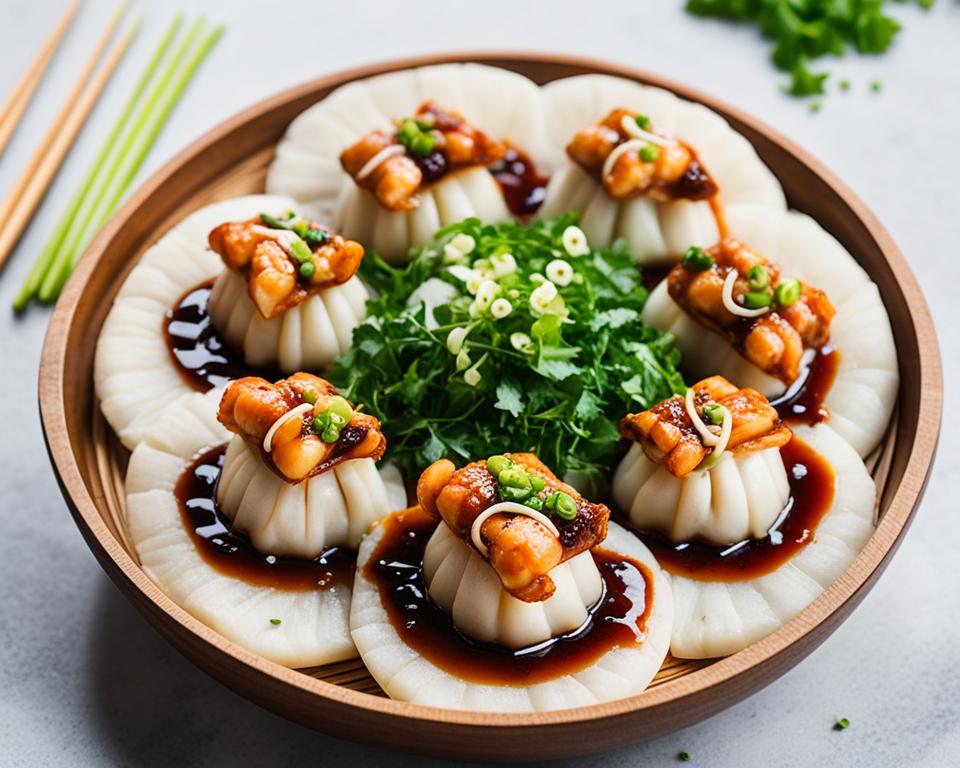
Baozi: A Street Food Sensation
Baozi, the beloved Chinese steamed buns, have moved beyond dim sum to become a street food sensation. These tasty snacks are found on carts and stalls in busy Chinese cities. They offer a quick and enjoyable way to experience Asia’s rich food culture.
The charm of baozi comes from their variety. They have savory and sweet fillings like pork, chicken, red bean, and custard. Each type bursts with flavor, making them great for a quick snack or a satisfying meal.
Street food vendors are experts at making baozi. They quickly and skillfully shape these buns. Watching them fold and pleat the dough is impressive. These patterns not only look great but also make eating them more enjoyable.
“Baozi are the ultimate street food – portable, affordable, and incredibly delicious. They’re a true reflection of the vibrant food culture in China.”
Baozi are not just food; they offer a cultural experience. Eating a fresh baozi lets you feel the lively street life of China. It’s a chance to enjoy flavors passed down through generations.
When you’re in Beijing or Shanghai, the smell of baozi will draw you in. It invites you to start a tasty adventure in Asian street food.
The Art of Pleating Baozi
The art of pleating baozi, a favorite Chinese steamed bun, shows the skill of chefs and home cooks. This process makes the buns look great and keeps the fillings inside. It’s key for the right texture too.
Pleating the baozi dough needs careful folds and pinches. It’s a skill that takes time and practice. The dough is gathered around the filling, then pinched and folded to make pleats. These pleats shape the baozi into its unique form.
This detail is not just for looks; it seals the baozi and keeps the filling in. When steamed, the baozi comes out perfectly cooked, juicy, and soft. This is what makes Chinese cuisine special.
Enjoying baozi as a snack or in a dim sum meal shows the art of pleating. It’s a sign of skill and hard work from those who make these Chinese treats.
Flavor Profiles: Sauces and Condiments
Baozi, a favorite Chinese steamed bun, comes with savory sauces and condiments. These add to the dining experience, letting diners customize their baozi. They bring extra layers of taste to the buns and their fillings.
Dipping Sauces and Garnishes
Common dipping sauces for baozi include soy sauce, chili oil, rice vinegar, and sweet and sour sauce. These sauces match well with the buns and let diners try new tastes.
- Soy sauce: A classic choice, soy sauce adds a savory, umami-rich flavor to the baozi.
- Chili oil: For those who like spice, chili oil adds a kick to the baozi.
- Rice vinegar: Its tangy, slightly sweet taste offers a refreshing contrast to the baozi.
- Sweet and sour sauce: This sauce blends sweet, sour, and sometimes savory condiments. It adds a delightful complexity to the baozi.
Baozi are also garnished with fresh herbs, chopped scallions, or sesame seeds. These add to the bun’s look and give an extra flavor burst.
| Dipping Sauce | Flavor Profile | Recommended Baozi Fillings |
|---|---|---|
| Soy Sauce | Savory, umami | Pork, chicken, or vegetable fillings |
| Chili Oil | Spicy, heat | Beef, lamb, or spicy vegetable fillings |
| Rice Vinegar | Tangy, slightly sweet | Pork, seafood, or sweet vegetable fillings |
| Sweet and Sour Sauce | Sweet, sour, savory | Pork, chicken, or mixed vegetable fillings |
The mix of delicate baozi and vibrant sauces and condiments makes this dish captivating and versatile. With many flavor combinations to try, diners can make their baozi experience unique. This creates a memorable culinary journey.
Vegetarian and Vegan Baozi Options
For those following a vegetarian or vegan lifestyle, baozi are a tasty and flexible choice. You can fill them with mushrooms, tofu, or various veggies for a tasty vegetarian baozi. Vegan baozi are also out there, filled with plant-based proteins or dairy-free stuff. These options welcome everyone to enjoy the joy of eating baozi.
If you’re a vegetarian looking for a tasty snack or a vegan wanting a yummy dim sum, baozi are perfect. Let’s dive into the tasty world of vegetarian and vegan baozi choices.
Filling the Void: Vegetarian Baozi
- Mushroom-Stuffed Baozi: Finely chopped mushrooms, sautéed with aromatics, make for a hearty and umami-rich filling.
- Tofu and Vegetable Baozi: Firm tofu combined with a colorful array of fresh veggies, seasoned to perfection.
- Sweet Potato and Spinach Baozi: A delightful pairing of creamy sweet potato and nutrient-dense spinach.
Dairy-Free Delights: Vegan Baozi
- Lentil and Carrot Baozi: Protein-packed lentils and vibrant carrots create a satisfying vegan filling.
- Quinoa and Roasted Pepper Baozi: Fluffy quinoa and roasted bell peppers make for a flavorful vegan option.
- Mushroom and Edamame Baozi: The umami of mushrooms and the crunch of edamame come together in this vegan delight.
With these diverse vegetarian and vegan baozi choices, everyone can enjoy the delicious world of these beloved Chinese steamed buns.
Baozi in Modern Chinese Cuisine
Baozi have a long history in Chinese cuisine. Now, they’re also part of modern culinary trends. Chefs and home cooks are trying new flavors and styles, making baozi their own. This shows how baozi are fitting into the modern Chinese food scene.
Fusion baozi are a big hit, mixing global tastes with traditional baozi. You might find fillings like Mexican chorizo, Italian pesto, or South Asian spices. This brings new flavors to the classic baozi.
Modern baozi are also about looks. Chefs use special techniques and bright colors to make them look amazing. These buns are now the stars of the plate, catching people’s eyes with their beauty.
The baozi is staying popular as Chinese cuisine changes. It shows how well this dish can adapt and stay loved. Baozi is a key part of China’s food history, showing its lasting appeal.
“Baozi are the perfect canvas for chefs to showcase their creativity and innovation. The possibilities are endless when it comes to reinventing this beloved Chinese staple.”
Xiaolongbao: The Soup-Filled Cousin
Xiaolongbao are a special kind of baozi known for their soup inside. They are filled with a tasty broth and minced pork. This makes every bite a burst of flavor. The way they are made, sealing the soup inside, is a key part of their charm in Chinese cuisine, especially in the Jiangnan region.
The secret to xiaolongbao is in their dough and how they are sealed. The dough must be thin and flexible to hold the soup inside. The way the dough is pleated and folded is an art. It takes skill to make the buns look right and keep their shape when steamed.

When served, xiaolongbao are put in a bamboo steamer to stay hot and keep their softness. Everyone gets excited as they pierce the buns. This lets out the rich broth that goes perfectly with the soft pork inside.
Whether eaten as part of a Chinese cuisine meal or on its own, xiaolongbao have won over food lovers everywhere. This special type of baozi shows off the variety and skill in Chinese cuisine. It’s a global favorite thanks to its unique taste and the craftsmanship behind it.
Homemade vs. Restaurant Baozi
When it comes to enjoying baozi, you can choose between making them at home or getting them from a restaurant. Each way has its own benefits, fitting different tastes and dining needs.
Pros of Homemade Baozi
- Personalized fillings and flavors: Making baozi at home lets you pick the ingredients and fillings you like best.
- Control over ingredients: You can make sure your baozi are made with fresh, healthy ingredients.
- Cost-effectiveness: It’s often cheaper to make baozi yourself than buying them at a restaurant.
Pros of Restaurant-Style Baozi
- Expertly crafted presentation: Restaurant baozi look great because chefs shape and steam them with care.
- Convenience: Getting baozi from a restaurant saves you time and effort.
- Authentic flavors: Restaurant baozi might taste more authentic because chefs know the traditional recipes well.
Choosing between homemade and restaurant baozi depends on what you prefer and what you’re looking for in a meal. Both ways let you enjoy the tasty flavors of this Chinese treat.
Baozi as a Cultural Icon
Baozi, the beloved Chinese steamed buns, have become more than just food. They are cherished cultural icons. These simple yet tasty treats carry deep meaning, showing the rich traditions and beliefs of China.
Long ago, baozi were seen as symbols of good luck and wealth. They played a big part in Chinese festivals and celebrations. The Lunar New Year is when families come together to make and enjoy these dumplings. They welcome the new year with hope and joy.
Baozi are loved all over China and the world, showing their importance as a cultural treasure. In places like Hong Kong’s dim sum houses and Beijing’s street vendors, the smell of fresh baozi is familiar. It brings back memories and makes people feel connected.
“Baozi are not just food – they are a symbol of our heritage, a bridge between generations, and a reflection of the vibrant diversity of Chinese cuisine.”
As baozi become more popular worldwide, their cultural importance grows. They act as ambassadors of Chinese food culture. They introduce the world to the flavors and traditions that China values deeply.
Baozi can be enjoyed alone or with family and friends. They are a symbol of the spirit and values that have shaped Chinese society for centuries. As a cultural icon, they remind us of the power of food to connect us to our heritage and celebrate our shared humanity.
Conclusion
The journey through the world of baozi, the iconic Chinese steamed buns, has been enlightening. It showed us the flavors, traditions, and innovation in Chinese cuisine. These fluffy delights have won the hearts and taste buds of people worldwide.
They’ve become a beloved part of Chinese cuisine and culture. As we end this delicious journey, it’s clear that baozi will keep evolving. It will continue to inspire new culinary creations, highlighting the rich flavors of China.
Whether enjoyed as a classic dim sum, a street food treat, or a homemade delight, these steamed buns will always be cherished. They will delight and nourish people for generations to come.
The story of baozi shows how traditional cuisine can adapt and thrive today. It blends the old with the new perfectly. As we finish, we appreciate the artistry, skill, and cultural importance of these Chinese delicacies even more.
